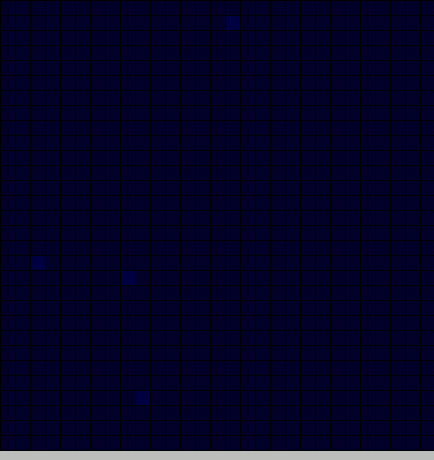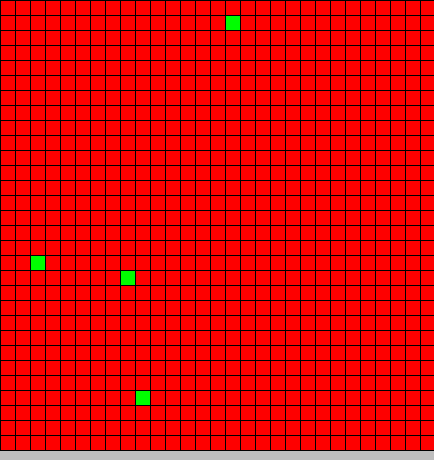Paris/Cell auto
From 2007.igem.org
In this part of our work, we aim at characterizing the diffusion of the DAP and the effect on the cells differentiation. This study consists in observing by simulation, the diffusion of DAP in a lawn of germ cells with some isolated somatic cells using a cellular automaton.
Contents |
Introduction
DAP feeding between somatic and germ cells is based on an indirect communication process: soma cells produce DAP and release it in the environment; DAP molecules freely diffuse outside until they are captured by a germ cell.
Hypotheses
We work with a constant population (no death and no division), we can imagine that we are a stationary phase or between to division cycle.
Without DAP a cell can't do anything, so it seems that DAP wake up bacteria but it's just an artifact.
The differentiation is DAP dependent, it's append when the cell as enough DAP to evolve but not enough to divide.
The DAP is made in bacteria S, the production rate is the difference between the total production and self consummation
The DAP can be under two types intra/extra cellular (DAPi/DAPe)
The DAP is consumed in bacteria G
We have 3 bags and 2 entities in our model
- bag
Bact it has a concentration internal of DAP (DAPi) and external (DAPe). It's a cell in our automaton
BactS is a Bact which produce DAPi
BactG is a Bact which consume DAPi
- entity
DAPi internal value of DAP
DAPe external value of DAP
We produce this set of rules
For bactS
*DAPe = DAPe + DAPe_diffused_in_neighborhood + DAPi_diffused_from_the_BactS
*DAPi= DAPi +DAPi_produced - DAPi_diffused_from_the_BactS
For BactG
*DAPe=DAPe + DAPe_diffused_in_neighborhood - DAPi_diffused_from_the_BactG
*DAPi= DAPi -DAPi_consummate + DAPi_diffused_from_the_BactG
*BactG = if minimal DAPi for differentiation < DAPi < maximal DAPi for differentiation BactS else stay BactG
Initial state
We use a 30x30 cells automaton.
All cells are BactG excepted 4 BactS which are placed randomly on the automaton
Parameters
We have 8 parameters and we can add noise for each of them.
In BactS:
- Dap export
- Dap import
- Dap production
In BactG:
- Dap export
- Dap import
- Dap consummation
- Minimal Dap needed for differentiation
- Maximal Dap needed for differentiation
Output
We use gbview to generate those pictures
The output is two animated pictures one show the differentiation the other the diffusion of DAPe


- The first picture show the diffusion of DAP
- We can see a front wave in light blue after that there is a dark blue area in which the systeme is stable the concentration doesn't evolve.
- The second picture show the differentiation
- Red BactG
- Green BactS
- The differentiation follow the wave front
In reality this phenomenon does not exist, but this model show that the low concentration of DAP induces differentiation (cells become green)(dark blue),then with high concentration of DAP, the differentiation is inhibited. That why some cells stay in red
We can also note that the population can be stabilized, and the level of DAP remains constant in these areas, the color of the cells doesn't change anymore and the concentration of DAP doesn't change too.
After playing with the parameters, we can deduct 2 important things:
- The inhibition most be strong and effective (we play with the minimal and maximal value of DAP for differentiation)
- if it isn't the case the system collapse all the bactG stay BactG if the inhibition is too strong or switch to BactS if the inhibition is not enough strong.
- The production and diffusion of DAP will be a critical factor
- The DAP has to be produce then he will be exported, it will diffuse in the medium and will be imported
- There is no proof of a special system to import or export DAP, so for each step there is a large amount of DAP lost.
